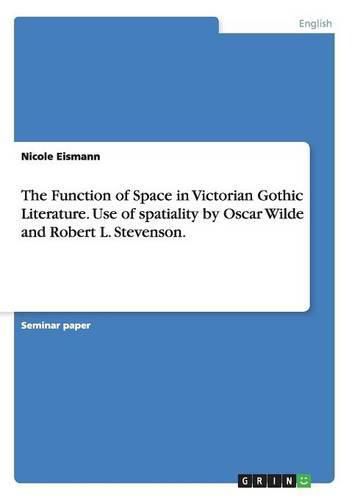Readings Newsletter
Become a Readings Member to make your shopping experience even easier.
Sign in or sign up for free!
You’re not far away from qualifying for FREE standard shipping within Australia
You’ve qualified for FREE standard shipping within Australia
The cart is loading…






Seminar paper from the year 2015 in the subject English Language and Literature Studies - Literature, grade: 1.3, University of Bonn (Institut fur Anglistik, Amerikanistik und Keltologie), course: Victorian Literature an Culture, language: English, abstract: This paper deals with the use of different spaces in the two Victorian Gothic stories The Picture of Dorian Gray and The Strange Case of Dr. Jekyll and Mr. Hyde and compares important places, houses and their meaning for the respective plots. Besides the city of London, which is the common overall setting of both novels and will be discussed in chapter 3, the paper focuses on the house as a traditional space for Gothic fiction and one of the elements that both texts have in common. Preliminarily, the character and meaning of the literal and metaphorical threshold will be made a subject of discussion. A story’s setting is an important factor for each literary work. Together with the story time it provides on the one hand a framework for the plot, on the other hand the space around which characters can move more or less freely throughout the story. Literal spaces represent the interaction of different factors, that all characterize the space: among these of course typical place descriptions like nature or architecture of buildings, but also abstract concepts like the weather, light and darkness or countless sensory impressions that a special place can offer, and of course life - human and non-human - that colonizes the space. Literary spaces, however, do not only function as places for actions and happenings but are functionalized in different ways. One purpose of space, that is especially important for Gothic fiction, is to set the mood of the story, which also implies to capture the fears and issues of the respective time and use them to create a certain atmosphere around the plot. During the Victorian era, issues like sciences, especially psychology and the human psyche, were omnipresent. But also urbani
$9.00 standard shipping within Australia
FREE standard shipping within Australia for orders over $100.00
Express & International shipping calculated at checkout
Seminar paper from the year 2015 in the subject English Language and Literature Studies - Literature, grade: 1.3, University of Bonn (Institut fur Anglistik, Amerikanistik und Keltologie), course: Victorian Literature an Culture, language: English, abstract: This paper deals with the use of different spaces in the two Victorian Gothic stories The Picture of Dorian Gray and The Strange Case of Dr. Jekyll and Mr. Hyde and compares important places, houses and their meaning for the respective plots. Besides the city of London, which is the common overall setting of both novels and will be discussed in chapter 3, the paper focuses on the house as a traditional space for Gothic fiction and one of the elements that both texts have in common. Preliminarily, the character and meaning of the literal and metaphorical threshold will be made a subject of discussion. A story’s setting is an important factor for each literary work. Together with the story time it provides on the one hand a framework for the plot, on the other hand the space around which characters can move more or less freely throughout the story. Literal spaces represent the interaction of different factors, that all characterize the space: among these of course typical place descriptions like nature or architecture of buildings, but also abstract concepts like the weather, light and darkness or countless sensory impressions that a special place can offer, and of course life - human and non-human - that colonizes the space. Literary spaces, however, do not only function as places for actions and happenings but are functionalized in different ways. One purpose of space, that is especially important for Gothic fiction, is to set the mood of the story, which also implies to capture the fears and issues of the respective time and use them to create a certain atmosphere around the plot. During the Victorian era, issues like sciences, especially psychology and the human psyche, were omnipresent. But also urbani